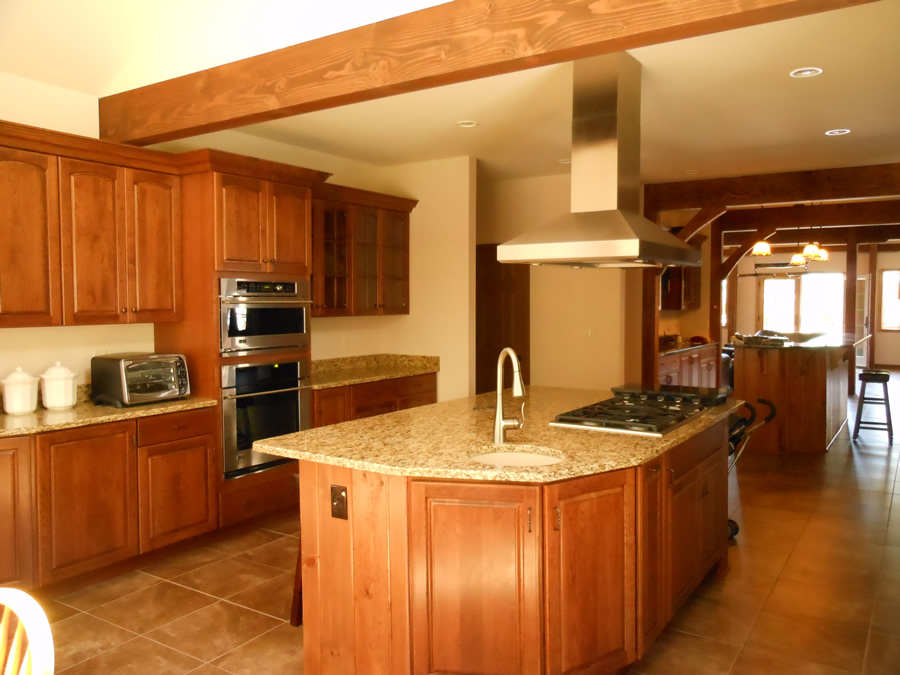Selecting the right countertop for your new kitchen or remodeled kitchen can be a challenging task. There are many types of materials and colors to choose from in a wide range of prices. Many years ago countertops were made of either wood or stone. Then years ago laminate countertops were top of the line. Today, however, there are many choices from laminate, to solid surface, to engineered stone, to granite and natural stone. Countertops today are no longer just for preparing lunch for our kids or dinner for the family, they can be the center or showplace of your home. Consequently you should select the countertop that suits your lifestyle and activities. Also think about how long you plan to stay in the home. The longer you plan to stay in the home the more durable and high-end the product. The cost per year becomes minimal the longer you stay in the home. A more neutral color, pattern, or design makes it easier to decorate and or remodel in future years without changing the countertop.
Let’s group our countertops into four classifications or types. Starting with the most inexpensive, we have the laminates. There is a huge range of colors and patterns available and laminate countertops are relatively easy to maintain. Unlike other materials, laminates usually don’t require any type of special maintenance such as a sealer to keep things looking nice. Sharp knives and hot pans will damage the surface. Simple common sense maintenance such as wiping up spills, using cutting boards and hot pads will keep your laminate top looking great for many years.
The next category is solid surface countertops. The standard for solid surface countertops was set by DuPont when that company introduced Corian. Today the term Corian is synonymous with solid surface countertops. There are, however, other solid surface manufacturers. Don’t limit your selection options to Corian, shop around. Other manufacturers may have just the color or pattern that you desire. Solid surface tops are made from acrylic polymer and alumina trihydrate, in layman’s terms, a hard plastic. It’s non-porous and can be used in special environments such as hospitals and laboratories. Since these countertops can be installed without seams, you don’t have to scrub away any dirt trapped in a seam. The material is relatively stain free and scratches or burns can usually be repaired. Also the sink can be mounted seamlessly beneath the countertop thus eliminating any seams between the sink and countertop. There is a downside to solid surface material. It has poor resistance to heat. Hot pots and pans can “burn” the material. Don’t place a hot frying pan directly on the surface. Again common sense says use a hot pad and cutting board. Also over time the surface may dull and need some buffing to bring back that fresh look. Depending on the color and material design, it can be a pricey option. Shop around, you may find a manufacture of solid surface material with a better price and selection.
The next category is engineered stone. Engineered stone is basically crushed stone bound together by glue or binding agent. It is made in a factory, polished by fabricators, and assembled at the job site. It’s the closest thing to real granite or natural stone. Since the material is basically made of stone, it is resistant to scratching and its non-porous surface is hard to stain. Engineered stone is typically less porous than stone. Being less porous, there is less opportunity for mold and mildew than with traditional granite or natural stone. Because of the way the engineered stone is manufactured, it doesn’t need to be sealed. As with the other materials we discussed, it’s always a good idea to avoid placing hot pans on the surface. It’s best to use a hot pad or trivet and a cutting board. Also, the agents used to bind the crushed stone tend to be a little more flexible and can withstand some movement. So if you have a very long countertop and there may be some movement, engineered stone should be considered. These polyester resin binding agents are susceptible to UV sunlight and tend to break down over time if exposed to the sun. Continued exposure to the sun can cause discoloration. Therefore, engineered stone is not recommended for outdoor use. Be aware, however, that you are now moving into the higher priced countertops and since the material is manufactured and distributed in slabs, the installation for your application may require a seam. Also with engineered stone, your sink cannot be integrated seamlessly with the countertops as it can be with a solid surface material. There will be some sort of seam between the countertop and sink.
The last and most expensive countertops are made from granite and natural stone. Granite or natural stone is a very hard surface and is very resistant to heat. It’s still not a bad idea to use hot pads or trivets and cutting boards, but if you forget, granite is the most forgiving. This type of surface should be sealed and if done so it can withstand most stains and is even more resistant to heat. Granite tops are very long lasting and present a very rich luxurious appearance to any kitchen or bath. Since it is a product of nature, each countertop is unique and no one will have the same countertop as you have. With your unique countertop you have the option of installing an under mount or drop-in sink. Since the material is porous it is susceptible to mold and mildew and should be sealed periodically. The stone can be scratched and if not sealed properly, liquids can penetrate the surface and leave a “water mark” if not cleaned up quickly. Obviously because of the natural material seams are very evident especially if the surface has a predominant pattern. If you select a natural stone such as marble, be aware that it stains very easily and is not recommended for kitchen countertops.





